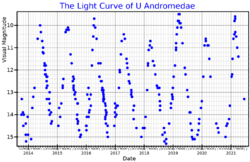Astronomy:U Andromedae
| Observation data Equinox J2000.0]] (ICRS) | |
|---|---|
| Constellation | Andromeda |
| Right ascension | 01h 15m 29.69623s[2] |
| Declination | +40° 43′ 08.3932″[2] |
| Apparent magnitude (V) | 9.0 to 15.0[3] |
| Characteristics | |
| Spectral type | M6e[3] |
| Variable type | Mira[3] |
| Astrometry | |
| Radial velocity (Rv) | −4.0±5[4] km/s |
| Proper motion (μ) | RA: 11.416±0.321[2] mas/yr Dec.: −8.392±0.297[2] mas/yr |
| Parallax (π) | 1.4745 ± 0.1511[2] mas |
| Distance | approx. 2,200 ly (approx. 680 pc) |
| Details | |
| Temperature | 3,288[2] K |
| Other designations | |
| Database references | |
| SIMBAD | data |
U Andromedae is a variable star in the constellation of Andromeda, at a distance of approximately 2,200 ly. It is a star of spectral type M6e and it is classified as a Mira variable.
U Andromedae is the variable star designation of this star. Its brightness varies by several magnitudes with a mean period of 347.7 d, although the exact length of each cycle is somewhat variable. Similarly, the magnitude of each maximum and minimum varies. The mean apparent magnitude is 11.6, with a mean maximum magnitude of 9.9.[6] The brightest recorded maxima are at magnitude 9.0, and the faintest minima at magnitude 15.0.[3] The rise to maximum brightness is faster than the fall to minimum, taking on average 40% of the period.[7]
The large amplitude, long period, and shape of the light curve mean that U Andromedae is classified as a Mira variable, a type of pulsating asymptotic giant branch (AGB) star.[3] It was first observed to be variable by Thomas D. Anderson during 1894 and 1895.[8][9] AGB stars have exhausted both hydrogen and helium in their cores and are not massive enough to fuse carbon and oxygen, so they erratically fuse helium and hydrogen shells outside the core.[10]
References
- ↑ "Download Data". AAVSO. https://www.aavso.org/data-download.
- ↑ 2.0 2.1 2.2 2.3 2.4 2.5 Brown, A. G. A. (August 2018). "Gaia Data Release 2: Summary of the contents and survey properties". Astronomy & Astrophysics 616: A1. doi:10.1051/0004-6361/201833051. Bibcode: 2018A&A...616A...1G.
- ↑ 3.0 3.1 3.2 3.3 3.4 U And, database entry, Combined General Catalog of Variable Stars (GCVS4.2, 2004 Ed.), N. N. Samus, O. V. Durlevich, et al., CDS ID II/250.
- ↑ Wilson, Ralph Elmer (1953). "General catalogue of stellar radial velocities". Carnegie Institute Washington D.C. Publication. Bibcode: 1953GCRV..C......0W.
- ↑ "U And". SIMBAD. Centre de données astronomiques de Strasbourg. http://simbad.u-strasbg.fr/simbad/sim-basic?Ident=U+And.
- ↑ Clayton, M. L.; Feast, M. W. (1969). "Absolute Magnitudes of Mira Variables from Statistical Parallaxes". Monthly Notices of the Royal Astronomical Society 146 (4): 411–421. doi:10.1093/mnras/146.4.411. Bibcode: 1969MNRAS.146..411C.
- ↑ "U Andromedae". https://www.aavso.org/vsx/index.php?view=detail.top&oid=4.
- ↑ Anderson, Thomas D. (1895). "New variable star in Andromeda". Astronomische Nachrichten 139: 117. Bibcode: 1895AN....139Q.117A.
- ↑ Chandler, S. C. (1896). "Third catalogue of variable stars". The Astronomical Journal 16: 145. doi:10.1086/102484. Bibcode: 1896AJ.....16..145C.
- ↑ Woźniak, P. R.; Williams, S. J.; Vestrand, W. T.; Gupta, V. (2004). "Identifying Red Variables in the Northern Sky Variability Survey". The Astronomical Journal 128 (6): 2965. doi:10.1086/425526. Bibcode: 2004AJ....128.2965W.
 |


